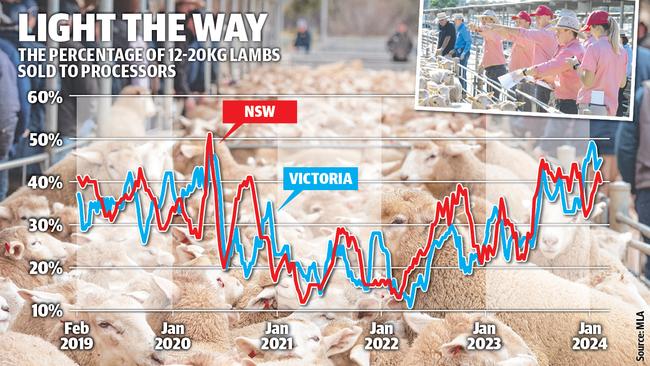Store lamb buying
As lamb prices swell to above 700c/kg, data shows the number of light lambs sold to processors last spring was at its highest level in more than five years.

Fewer lambs went out to the paddock in the spring, which means fewer lambs to come back into processors this autumn and winter.
It is a simple argument that has already been a factor in the swift rise in heavy and trade weight lamb prices to above 700c/kg this January.
So just how extreme was the lack of farmer confidence in the spring sucker flush as traders looked at the dry seasonal forecast and bad trading outcomes of the previous year and effectively turned their backs on store lambs?
Saleyard figures collected by the National Livestock Reporting Service suggest during the key store months of October, November and December the number of light lambs sold to processors was at its highest levels for more than five years.
For this analysis the data set used was light lambs sized between 12-20kg carcass weight and sold at weekly prime markets monitored by the NLRS, which includes Bendigo, Ballarat, Hamilton, and the NSW centres of Wagga Wagga, Dubbo, Cowra, Corowa, Griffith and Forbes.
In NSW, the percentage of light lambs sold to meatworks tracked above 40 per cent across most of the spring, peaking at 44 per cent.
While it does not sound high, it is much greater than previous seasons, and the last time it trended near these levels was in the drought year of 2019 (see graphic).
In Victoria, the percentage of light lambs sold to processors varied from 33 per cent to 49 per cent during the spring months, but hit very high levels in late November and December when big numbers of suckers were being sold out of the Western District.
The trend of a lot of light lambs selling to processors rather than back to restockers has continued into January. The Victorian figure is still tracking above 44 per cent as store lamb prices rise and the availability of decent light lambs remains scarce after all the rain.
To simplify the figures, in recent months for every 10 light lambs yarded 3.5 to five were selling to meatworks and being processed out of the supply chain. In most other years the ratio is 2 to 3.5 selling to meatworks.
It shows up in the graphic which illustrates the trendline in percentage terms for light lambs sold to processors during the past five years.

This NLRS data follows some analysis done by Nutrien that also showed a big uptick in the number of lambs sold to meatworks out of their agency at key southern prime markets.
Nutrien southern livestock manager Adam Mountjoy said they delved into the data to better understand what had happened in the spring lamb market and how it could shape prices and supply going forward. Nutrien analysed its agency lamb sales at Bendigo, Ballarat and Naracoorte in South Australia for the seven week period from October 1 to November 21, which covers the heart of the spring sucker flush.

Mr Mountjoy said at these three selling centres Nutrien sold an extra 140,000 lambs in this time-frame, partly due to a lack of forward prices offered by meatworks and online selling losing its momentum which diverted more stock into the auction system.
But even allowing for the increased numbers of lambs sold by Nutrien, sales to the paddock were still down by 9 per cent. The key figures from the analysis were 26 per cent more lambs sold, but 9 per cent fewer back to restockers and 47 per cent slaughtered out of the system.
“Its why we are seeing a peak in the lamb market now as there was no desire early in the season to put lambs out. The take home message is more light lambs went to bag lamb orders and this should support prices going forward into the autumn and winter,” Mr Mountjoy said.
All the evidence supports the theory the carry-over pool of lambs is less than recent seasons, but to what extent the market can lift is still debatable. If you refer back to 2019-20, it shows after more numbers of light lambs than usual went to processors the lamb market did hit highs the following autumn. According to NLRS figures the heavy lamb price indicator hit an average of 900c/kg carcass weight in March-April of 2020.
There are so many variables that go into supply and pricing that it is difficult to quantify how the collapse in store lamb buying that happened late last year will fully impact the market going forward.
At this stage farmers still holding lambs appear to be in a strong position. But that said it is already evident that many processors are not comfortable with lamb prices tracking above 700c/kg. The control they can extort is to lower production or kill less, and there is already more mutton to fill schedules.




